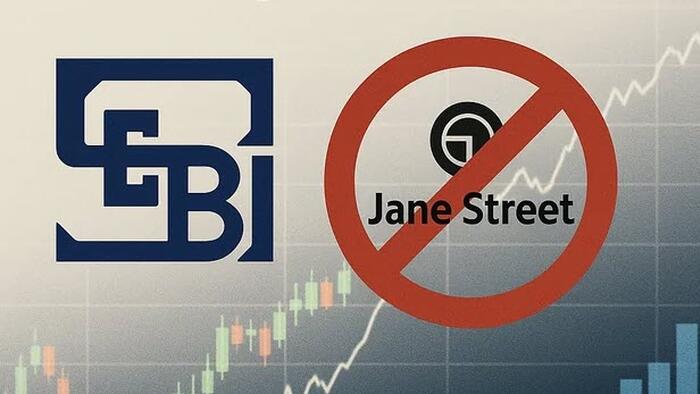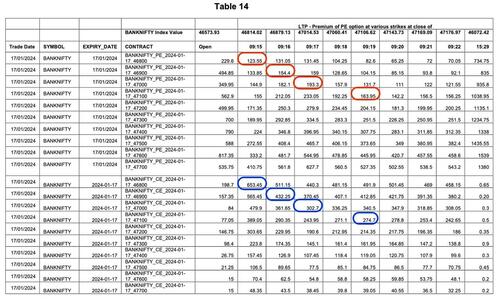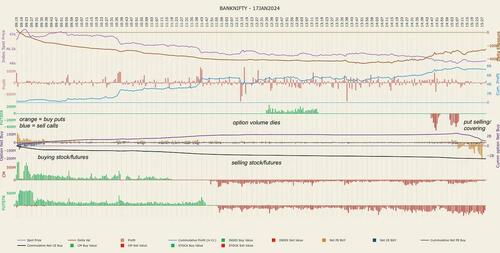


Days ago India barred Jane Street (JSG) from its security market, citing manipulation of markets.
TLDR: We think JSG knew options skews could be heavily distorted, and traded large options positions trying to take advantage of the distortion.
Additionally - a disclaimer: We have no idea what really happened, and we did our best to accurately quote from the SEBI & other documents. We have no idea if anyone is guilty of anything, nor are we alleging that. If anything in here is incorrect, we will do our best to update the post.
The Indian regulatory body, SEBI, launched the investigation “Based on media reports titled ‘Jane Street-Millennium Suit: ‘Secret’ Strategy Concerns India, Hearing Reveals’ and ‘Ex-Jane Street trader pillories claims he stole trade secrets’, published during April 2024 wherein it was inter-alia mentioned that Jane Street and its associated entities alleged unauthorised use of their proprietary trading strategies in Indian options markets…”
This recent banning was related to a 2024 regulatory investigation (and warning to JSG) into short-dated index options trading. After that ‘24 investigation, SEBI, India’s market regulator, accused Jane Street of manipulating the BANKNIFTY index on expiry day using aggressive futures flow and deeply skewed 0DTE option structures — a strategy that mirrors the same tactics Jane Street would later allege were stolen in its U.S. lawsuit against Millennium (more on this later)
Critical to this, understand that Jane Street is/was not a registered market-maker in India’s options market. But according to SEBI’s 2024 interim order, they behaved like the most aggressive one in the room.
SEBI found that the Jane Street Group ("JSG") ran the single largest risk-adjusted book on BANKNIFTY index expiry days. One day stood out above the rest: January 17, 2024.
On element left from the report was that the day before, January 16, BANKNIFTY fell more than 4% following disappointing earnings from HDFC Bank. The January 17 session opened lower again — creating a setup where options prices were likely skewed to the extremes.
On Jan 17 SEBI estimates JSG made ₹662 crore (~$79M USD) that day using what they call an "Intraday Index Manipulation" strategy. The allegation? That Jane Street pushed BANKNIFTY higher in the morning by aggressively buying stocks and futures, built massive short-delta positions in 0DTE options while the index was artificially elevated, and then sold their equities to drive the index lower and monetize the short-delta.
This is also the depiction you hear on social media. But, as with most things, there is way more nuance.
Both the equities market and the options market opened at 9:15 AM IST. Jane Street began executing its strategy immediately. From 9:15 to 11:45 AM, JSG bought ₹4,370 crore ($525M) of BANKNIFTY futures and stocks. This alone accounted for 15–25% of total traded value in those names. Simultaneously, they shorted delta* to the tune of ₹32,115 crore ($3.9B) via 0DTE options — selling calls and buying puts.
In plain terms, Jane Street put on a massive intraday risk reversal by selling same day expiration (a.k.a. 0DTE) at-the-money (ATM) calls vs ATM puts.
*As we noted before, the BANKNIFTY was down 4% the prior day, and was opening ~1% lower on the morning of the 17th. This is critical to understand, because they SEBI report goes to great lengths to detail the alleged delta exposure that JSG carried. With great respect to the regulator, we think that depicting accurate deltas into wild vols/skews is rather difficult.
I suspect that Jane Street likely anticipated that volatility skew would be heavily mispriced at the open, potentially due to the prior day's steep index decline. When the market opened, they bought futures and stock simultaneously against extremely skewed options — selling richly priced calls and buying heavily discounted puts. This structure effectively established risk reversals vs long futures to exploit the skew differential.
Initially, the position may have been close to delta-neutral — designed not for directionality, but to mine the skew. This is likely why they were buying stock (positive delta trades) and futures as they were entering into risk reversals (negative delta trades). Further, as the day progressed and the skew normalized, Jane Street ceased additional accumulation (per charts below).
What made the setup unique was the sheer distortion in option pricing. At 9:15 AM, spot BANKNIFTY was trading at 46,814. The 46,800 ATM call was priced at ₹653.45 (blue); the ATM put, just ₹123.55 (red). While we have not studied Indian options prices before, one would expect ATM calls and puts to have much more similar prices.
This inverted skew suggests calls were extremely rich vs puts, a perfect setup for the trade JSG implemented. By day’s end, that call expired nearly worthless (₹0.65), while put values exploded.
This is a clear breakdown of put-call parity, one that SEBI argues was engineered by Jane Street itself. Their aggressive equity buying misled other participants and skewed IV pricing, particularly in the ATM strikes, allowing JSG to put on the risk reversal at an extreme edge.
SEBI writes: “Participants in index options markets [were] misled by the support for BANKNIFTY.” The strategy was not just delta directional — it was vol- and skew-sensitive. Jane Street created short-term realized vol and harvested convexity on both sides.
Notably, option volumes themselves appeared to collapse once the skew normalized. The SEBI states that JSG’s flow was the primary driver of the distorted vol surface that they were mining. We think this is the critical piece which the argument rotates around - did they knowing create this skew or was it the result of market volatility?
By 11:47 AM, Jane Street began unwinding their long equity exposure as you can see above (bottom 2 bar plots). At this same time, the options volume dies out (center plot). SEBI notes that their selling was again aggressive and concentrated in BANKNIFTY components, disproportionately moving the index lower and inflating the value of their long puts.
They reportedly closed some positions, letting others expire ITM. Though they booked losses on equities, the options PnL overwhelmed it. SEBI estimates a ₹662 crore net profit.
This apparently wasn't a one-off. SEBI identified 15 other days using this same blueprint, plus 3 additional instances where Jane Street employed a variant: the "Extended Marking the Close" strategy. This involved building large delta positions in options during the day, followed by an aggressive equity ramp or selloff into the expiry window to influence the settlement print.
In April 2024, Jane Street sued Millennium and two former traders, alleging misappropriation of a confidential strategy. The complaint describes an SPX-based strategy developed over six years, involving:
Jane Street claims this strategy was unique and counterintuitive, and that its IP centered on exploiting subtle, repeatable intraday price dynamics. Internal chat logs cited in the complaint show the strategy was so profitable they considered hiding it from internal PnL tallies to avoid attracting attention.
Jane Street alleges that immediately after the traders joined Millennium, a new competitor began mirroring their trades via the same broker infrastructure, including specific order types and risk throttles. The broker even paused execution due to the similarity in patterns. Jane Street's own profits reportedly collapsed concurrently.
The Millennium lawsuit makes the BANKNIFTY trades even more revealing. According to Jane Street’s own complaint, their core strategy was explicitly designed to detect and trade on skewed volatility surfaces. It wasn’t just about forecasting direction — it was about identifying mispriced convexity and exploiting it through engineered flow. The “expensive investigative trades” described in the lawsuit align almost perfectly with the behavior SEBI observed in India: buying up underlying stocks to shift implied vols, then harvesting the reversion through options.
In both cases, infrastructure mattered — Jane Street touted proprietary execution pipelines, broker logic, and near-automated rebalancing. The precision seen on January 17 — with flow ramping at open, peaking by 11:45, and reversing in size — fits the exact framework Jane Street claimed was stolen.
If Jane Street had a strategy designed to weaponize short-term volatility dislocations using index-linked options and coordinated flows in the underlying, SEBI’s findings suggest it was indeed deployed.
Subscribe to SpotGamma's high frequency expert options analysis here...


